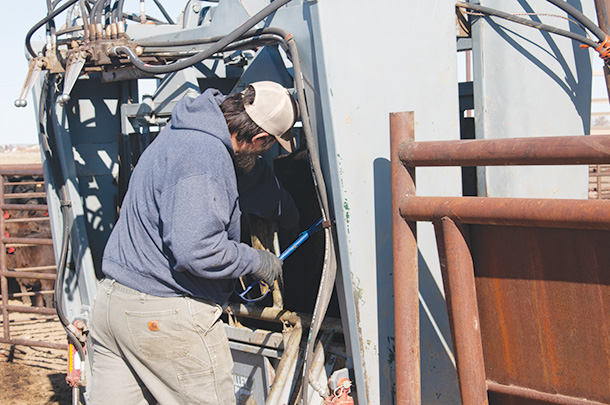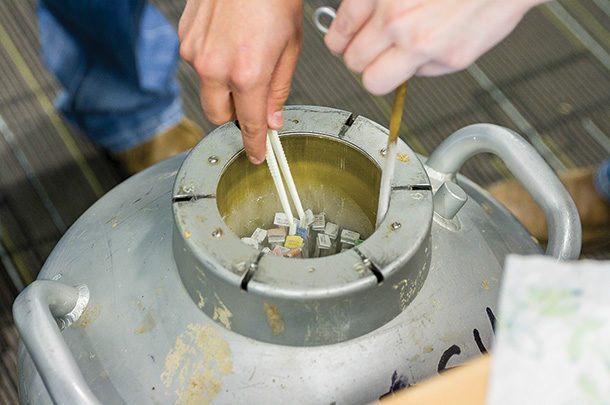Have you ever sat down and figured out what it costs to breed a cow? It might seem like an easy number to calculate, since we can add up all of our natural service bull purchases and subtract out the salvage value of any bulls sold. Of course, we need to add in the costs of pasture, feed and mineral for those bulls as well. We also need to include any health costs and routine care costs for those bulls. And don’t forget, we also ought to include the cost of repairing or replacing all of the things the bulls tear up – “if you know, you know,” as they say.
An economist might remind you to include opportunity costs as well; after all, the equity and other resources tied up by those bulls could have been used to generate a return in other ways. Perhaps leaving aside that last point, we ought to be able to come up with at least an approximation of the total dollar amount spent on breeding. Dividing that by the number of cows exposed, we come up with a breeding cost on a per-cow basis. What should that cost be?
Benchmarks
One way to attempt to answer cost-related questions is to look at others’ costs as a benchmark. I occasionally see benchmarks for breeding costs as low as the $40- per-cow range. We can debate whether we think that number is optimistically low – I tend to think it is. But today I have a different question in mind: If a $40-per-cow breeding cost is actually an attainable benchmark, why would any commercial producer ever invest $50 or so per cow in carrying out an estrous synchronization and fixed-time artificial insemination (A.I.) program?
 Estrus synchronization can help producers shorten the calving interval. Photo by Lynn Jaynes.
Estrus synchronization can help producers shorten the calving interval. Photo by Lynn Jaynes.
Let’s flesh out this comparison. Just for the sake of making it extreme, let’s say the use of a fixed-time A.I. program to begin the breeding season allows only a modest reduction in the number of bulls required on the farm or ranch, and the per-cow cost of natural service bulls in that situation still amounts to $30 per cow. In this hypothetical, then, the $50 per cow in added cost (synchronization products, labor, semen, etc.) brings the total breeding costs on a per-cow basis up to around $80. That is essentially double the $40 benchmark. How in the world, you might ask, could it ever be a profitable decision to double a cost of production like that?
A better management mindset
We have to be thoughtful about how we approach cost-related benchmarks. If you have a minute, take a look at the most recent Kansas Farm Management Association (KFMA) report, “Difference Between High-, Medium- and Low-Profit Cow-Calf Producers,” which summarized years 2016 through 2020. In those data, we see that high-profit operations have found a way to lower costs of production – while also increasing revenue, it should be noted. On a per-cow basis, high-profit operations surveyed had 23% ($284) lower total costs on a per-cow basis compared to the low-profit operations. The question becomes what we do with that information. Are we to slice away at every line item in the budget so that it is at or under each benchmark?
A quote comes to mind from Brian Joiner’s book Fourth Generation Management: “Real benefits come when managers begin to understand the profound difference between ‘cost-cutting’ and ‘eliminating the causes of costs.’” Good managers ask questions when they see costs that don’t line up with benchmarks. What is the underlying cause of the cost? What parts of the system drive this cost up or down? How does this one cost affect revenue or other costs in our cost structure? And here is a fun one: What costs are so comparatively affordable for this operation that it might be wise to build our system around them as our “unfair” advantage?
Incurring a higher-than-typical cost in one line item in the budget isn’t unreasonable at all if it reduces overall cost of production. In that KFMA data, for example, there is actually one cost category in which high-profit producers incur about 10% greater costs than low-profit producers: their pasture costs per cow are about $15 per cow per year greater. Why do those operations do that? I would argue it is because the high-profit operations use that investment in pasture costs as a leverage point to reduce costs associated with purchased feed inputs. High-profit operations operate with more realistic stocking rates – about a 10% greater number of acres per cow in the KFMA data – and presumably achieve a greater number of days in which cows harvest all or the majority of their own feed. As a result, high-profit producers who spent $15 more for pasture on a per-cow basis were able to spend $145 less on non-pasture feed costs per cow. Sounds like those “high pasture costs” were a pretty wise investment.
Invest in reproduction
Much like the pasture cost example, reproductive management really needs to be thought of as an investment. That investment can lead to increased revenue, of course. But an equally if not more exciting opportunity is to use the investment in reproductive management as a leverage point to decrease overall costs of production.
For the vast majority of cow-calf operations, the second-largest cost of production (after feed) is the loss in equity in the cow herd that occurs during the production year. Cow depreciation can be a hidden cost of production, especially since many operations raise rather than purchase replacements and therefore do not exactly write a check for the real cost of replacements each year. To approximate cow depreciation costs on a per-calf basis, take the total fair market value of replacement females purchased or retained minus the salvage value of cull cows and/or any marketed females. Divide that difference across the number of calves sold, and you have the cost of cow depreciation that is embedded into every calf produced. Be warned: This is often a staggering number.
Reproductive management is an opportunity to control the cause of that potentially staggering cost. We could theoretically decrease the cost of replacement females. We could increase the years of service or the longevity of cows in production. We could also increase the salvage value of cows at the time of sale – an often-overlooked strategy. For a more in-depth discussion, I will refer you to the University of Missouri Extension manual Whole System Management of Beef Cattle Reproduction, published last fall. The more we understand our operations as systems, the more investing in reproductive management starts to seem like a wise, lower-cost business model.
We have opportunities to turn cost-heavy cow-calf operations into functional businesses with healthy return ratios, but we won’t get there with simplistic cost-cutting. Consider whether a greater level of investment in estrous synchronization, A.I., pregnancy diagnosis and other reproductive management would address some of the causes of cost in your operation this year.









